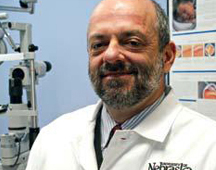 |
Eyal Margalit, M.D., Ph.D. |
Last winter, he transferred money from several collection baskets into one and knocked a small Christmas tree off a table, which scattered ornaments everywhere.
He’s able to laugh at himself, but the reason for Grimm’s clumsiness is no laughing matter. Grimm was diagnosed with retinitis pigmentosa about 15 years ago.
The disease causes progressive tunnel vision and eventually blindness. About 1.5 million people worldwide are affected.
Thankfully, Grimm maintains enough sight still to drive, but only during the day. His night vision is virtual blackness.
“I can’t see in the dark,” he said. “My wife and I went to see Elton John in concert last year and I couldn’t even enjoy it because when the lights went down, it was pitch black for me. And when it’s not well lit, I’m lost.”
For the most part, Grimm has adapted to his declining vision. He gives himself time to acclimate to varying levels of light and always carries a flashlight with him.
Like a child afraid of the dark, Grimm uses nightlights, but not because he’s scared. He’s embarrassed when he runs into things.
Nonetheless, he considers himself lucky.
“My retinitis pigmentosa has progressed slowly,” said Grimm, whose father and sister also have been diagnosed with the degenerative genetic disease. “But I know that it can depend on the patient.”
Others aren’t so fortunate
Mac Brush was diagnosed with retinitis pigmentosa in junior high school. His issue with not being able to read the chalkboard has now progressed to not being able to see anything but large objects in bright light.
At age 24, he is considered legally blind.
For Brush’s father, Bill, of North Loup, Neb., the disease has caused his son as much emotional devastation as it has physical deterioration.
He remembers when his little boy could still ride a bicycle and play soccer. Those days are long gone now.
Retinitis pigmentosa stole Mac’s confidence and independence. He now lives in a small group home and has been diagnosed with psychological issues aggravated by his blindness.
Bill Brush believes it’s because Mac refused to accept that he would eventually lose his vision.
“There were many people who tried to get Mac to accept his pending blindness, but it just didn’t work,” Brush said. “I enjoy my vision so much with what I get to see every day out here in western Nebraska — hawks, eagles, geese, stars and sunsets — the fact that my son can’t is very hard on me.”
Physician’s work brings hope
It is the dream of Eyal Margalit, M.D., Ph.D., for Brush to be able to share the sights of greater Nebraska with his son and for Jeff Grimm to watch a concert again.
Dr. Margalit, associate professor and director of the retina service at UNMC, hopes to make that dream a reality with the development of an innovative retinal implant that could restore lost vision.
|
“In the late ’80s and early ’90s, the idea came about to use electrical stimulation on the cells of the retina that were still intact,” Dr. Margalit said. “Ideally, the electrical stimulation would cause the brain to see light and create an image.”
How the treatment works
In order for a retinal implant to work, the patient must wear a pair of eye glasses that contain a camera with an electronic chip.
The “sender” chip in the glasses transfers digital information from the camera to a “receiver” chip implanted in the eye.
|
|
Following the completion of undergraduate and graduate school at The Hebrew University and his residency at Hadassah University Hospital in Jerusalem, Israel, Dr. Margalit did his research fellowship at the Wilmer Eye Institute at Johns Hopkins Medicine in Baltimore.
There, he contributed to the research and development of the first retinal implant.
Innovative researcher comes to Nebraska
Dr. Margalit left for UNMC in 2003, and researchers from Johns Hopkins (now at the University of Southern California) continued work on a retinal implant. They now seek U.S. Food and Drug Administration approval on a device with approximately 60 electrodes.
While that would be an improvement for patients like Brush and Grimm, it is estimated that it takes a minimum of 600 electrodes to stimulate the retina cells before humans begin to see enough detail for face recognition.
With funds from the U.S. Department of Veterans Affairs and the Nebraska Research Initiative, Dr. Margalit plans to improve an existing device with one that contains 3,200 electrodes, or 53 times that of the device developed by his colleagues. Dr. Margalit plans to develop a wireless device, which means surgery to attach it to the retina would be less invasive.
“With this device, there’s no cable penetrating the eye, which means less chance of infection and damage to the very delicate retina,” Dr. Margalit said.
Dr. Margalit also plans to incorporate an “encoder” in his device that would make it an “intelligent” implant.
With the help of a feedback mechanism and the behavioral response of the patient, such an implant would automatically change the amount of stimulation of the retinal cells.
Work remains
It will be three to five years before Dr. Margalit’s device is tested in clinical trials. Still, patients like Grimm, who have no other existing options available, are optimistic.
“It sounds really cool,” he said. “I’d jump at the opportunity for something that would improve my vision. It would make my daily routine much more comfortable.”
Brush acknowledges the potential physical implications, but notes that such an invention would have an emotional impact as well.
“It would just be terrific,” he said. “It would help restore vision and offer hope.”